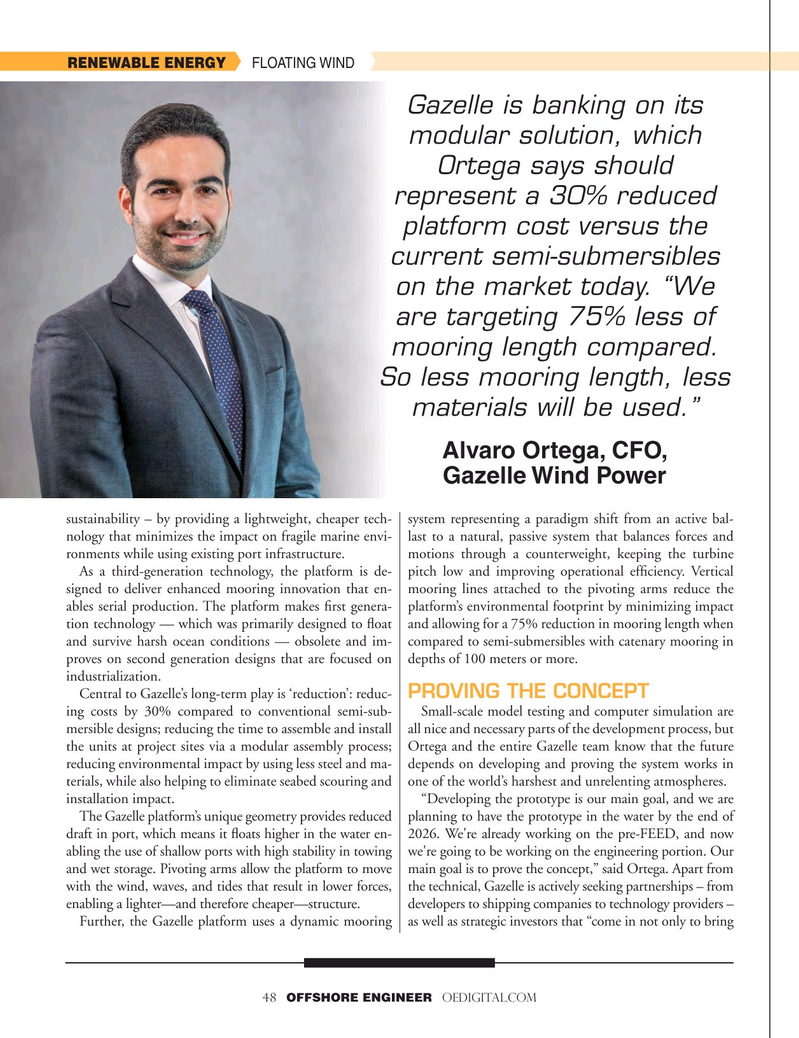
Page 48: of Offshore Engineer Magazine (Jan/Feb 2024)
Read this page in Pdf, Flash or Html5 edition of Jan/Feb 2024 Offshore Engineer Magazine
RENEWABLE ENERGY FLOATING WIND
Gazelle is banking on its modular solution, which
Ortega says should represent a 30% reduced platform cost versus the current semi-submersibles on the market today. “We are targeting 75% less of mooring length compared.
So less mooring length, less materials will be used.”
Alvaro Ortega, CFO,
Gazelle Wind Power sustainability – by providing a lightweight, cheaper tech- system representing a paradigm shift from an active bal- nology that minimizes the impact on fragile marine envi- last to a natural, passive system that balances forces and ronments while using existing port infrastructure. motions through a counterweight, keeping the turbine
As a third-generation technology, the platform is de- pitch low and improving operational effciency. Vertical signed to deliver enhanced mooring innovation that en- mooring lines attached to the pivoting arms reduce the ables serial production. The platform makes frst genera- platform’s environmental footprint by minimizing impact tion technology — which was primarily designed to foat and allowing for a 75% reduction in mooring length when and survive harsh ocean conditions — obsolete and im- compared to semi-submersibles with catenary mooring in proves on second generation designs that are focused on depths of 100 meters or more.
industrialization.
Central to Gazelle’s long-term play is ‘reduction’: reduc-
PROVING THE CONCEPT ing costs by 30% compared to conventional semi-sub- Small-scale model testing and computer simulation are mersible designs; reducing the time to assemble and install all nice and necessary parts of the development process, but the units at project sites via a modular assembly process; Ortega and the entire Gazelle team know that the future reducing environmental impact by using less steel and ma- depends on developing and proving the system works in terials, while also helping to eliminate seabed scouring and one of the world’s harshest and unrelenting atmospheres.
installation impact. “Developing the prototype is our main goal, and we are
The Gazelle platform’s unique geometry provides reduced planning to have the prototype in the water by the end of draft in port, which means it foats higher in the water en- 2026. We're already working on the pre-FEED, and now abling the use of shallow ports with high stability in towing we're going to be working on the engineering portion. Our and wet storage. Pivoting arms allow the platform to move main goal is to prove the concept,” said Ortega. Apart from with the wind, waves, and tides that result in lower forces, the technical, Gazelle is actively seeking partnerships – from enabling a lighter—and therefore cheaper—structure. developers to shipping companies to technology providers –
Further, the Gazelle platform uses a dynamic mooring as well as strategic investors that “come in not only to bring 48 OFFSHORE ENGINEER OEDIGITAL.COM

 47
47

 49
49